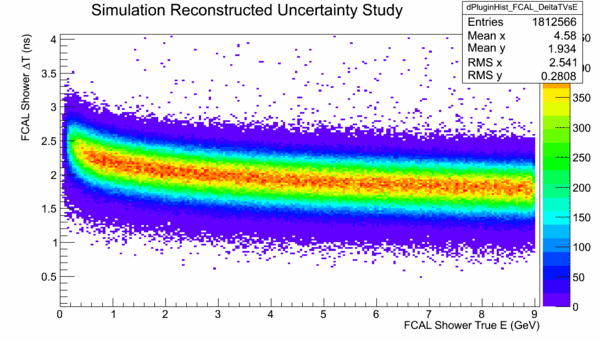Mattione Reconstruction Uncertainties
From GlueXWiki
Introduction
- I would like to update the current reconstruction uncertainties to improve the particle-ID algorithms and support the kinematic fitting analyses. Right now the tracking uncertainties are yielding dubious chi-squares and kinematic fits with too many events with low confidence levels. Also, the timing uncertainties used for calculating the particle-id FOM are one-size-fits-all numbers, instead of incorporating any momentum or energy dependence.
- I would like to fix these problems with the reconstruction uncertainties, and do so in a framework that can be used for experimental running. That way we will get a better understanding of the eventual experimental reconstruction uncertainties, and we won't need to rewrite the framework later.
Current Uncertainty Status
- For particle-id, one-size-fits-all values are used for the time uncertainties from the TOF, FCAL, and BCAL systems.
- The BCAL & FCAL systems have shower uncertainties, but there are no correlations between them (in the lab frame). For the FCAL, the shower time uncertainty is absent. Also, for the neutral tracks the uncertainties are all overridden later by a 7x7 diagonal (no correlations) error matrix.
- The start counter times are smeared with a fixed sigma of 300 ps in mcsmear.
- The tracking code (DTrackFitterKalmanSIMD) incorporates CDC and FDC hit uncertainties determined from fits to the simulated drift chamber residuals. These uncertainties are then propagated throughout the tracking code and into the final tracking covariance matrix.
TOF
FCAL
Time
- The reconstructed FCAL time is significantly offset from the simulated times.
- hd_dump of DFCALShower, DFCALTruthShower, and DFCALHit. Note that both the DFCALShower and DFCALHit times are ~2+ ns greater than the DFCALTruthShower times.
Event: 1 DFCALShower: E(GeV): X(cm): Y(cm): Z(cm): t(ns): -------------------------------------------- 3.27 -8.27 63.70 642.36 21.16 //Photon generated at target center (0, 0, 65), so path length = 580.922 and t should be = 19.377 DFCALTruthShower: x(cm): y(cm): z(cm): px(MeV/c): py(MeV/c): pz(MeV/c): E(MeV): t(ns): primary: track: type: --------------------------------------------------------------------------------------------- -8.0 61.7 625.3 -44.8 343.8 3123.6 3142.732 18.8 1 1 1 //Photon generated at target center (0, 0, 65), so path length = 563.744 and t should be = 18.8 //similar, additional hits were present but were truncated DFCALHit: row: column: x(cm): y(cm): E(MeV): t(ns): ---------------------------------------------- 44 26 -12.0 60.0 42.050 21.082 //similar, additional hits were present but were truncated
- In programs/Simulation/HDGeant/hitFCal.c the times saved to the s_FcalTruthShowers_t and s_FcalTruthHit_t objects are different: the s_FcalTruthHit_t times (which are later smeared and converted to DFCALHit objects) are increased to account for what looks like light propagation to the PMTs (line ~192). This isn't being taken into account in the DFCALCluster reconstruction code.
